
Coprinus is a small genus of mushroom-forming fungi consisting of Coprinus comatus—the shaggy ink cap (British) or shaggy mane (American)—and several of its close relatives. Until 2001, Coprinus was a large genus consisting of all agaric species in which the lamellae autodigested to release their spores. The black ink-like liquid this creates gave these species their common name "ink cap" (British) or "inky cap" (American).

Coprinus comatus, commonly known as the shaggy ink cap, lawyer's wig, or shaggy mane, is a common fungus often seen growing on lawns, along gravel roads and waste areas. The young fruit bodies first appear as white cylinders emerging from the ground, then the bell-shaped caps open out. The caps are white, and covered with scales—this is the origin of the common names of the fungus. The gills beneath the cap are white, then pink, then turn black and deliquesce ('melt') into a black liquid filled with spores. This mushroom is unusual because it will turn black and dissolve itself in a matter of hours after being picked or depositing spores.

Coprinopsis atramentaria, commonly known as the common ink cap, tippler's bane, or inky cap, is an edible mushroom found in Europe and North America. Previously known as Coprinus atramentarius, it is the second best known ink cap and previous member of the genus Coprinus after C. comatus. It is a widespread and common fungus found throughout the northern hemisphere. Clumps of mushrooms arise after rain from spring to autumn, commonly in urban and disturbed habitats such as vacant lots and lawns, as well as grassy areas. The grey-brown cap is initially bell-shaped before opening, after which it flattens and disintegrates. The flesh is thin and the taste mild. It can be eaten, but due to the presence of coprine within the mushroom, it is poisonous when consumed with alcohol, as it heightens the body's sensitivity to ethanol in a similar manner to the anti-alcoholism drug disulfiram.

Coprinopsis lagopus is a species of fungus in the family Psathyrellaceae. Until 2001, the species was known as Coprinus lagopus; advances in the understanding of phylogenetic relationships between the various coprinoid species led to a major reorganization of that genus. It is a delicate and short-lived fungus, the fruit bodies lasting only a few hours before dissolving into a black ink – a process called deliquescence. The vague resemblance of the young fruit body to the paw of a white rabbit has earned this species the common name harefoot mushroom.

Tulosesus amphithallus is a species of mushroom producing fungus in the family Psathyrellaceae.
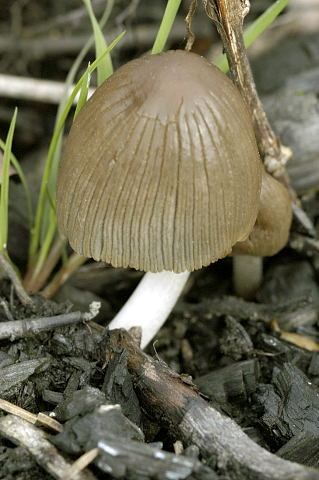
Tulosesus angulatus is a species of mushroom producing fungus in the family Psathyrellaceae.
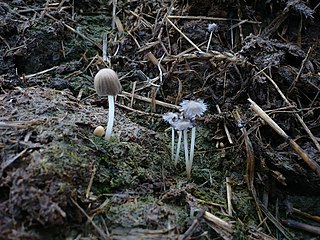
Tulosesus bisporiger is a species of mushroom producing fungus in the family Psathyrellaceae.
Coprinellus curtus is a species of mushroom in the family Psathyrellaceae. It was first described as Coprinus curtus by Károly Kalchbrenner in 1876 before being transferred to the genus Coprinellus in 2001.
Tulosesus callinus is a species of mushroom producing fungus in the family Psathyrellaceae.

Tulosesus bisporus is a species of mushroom producing fungus in the family Psathyrellaceae.
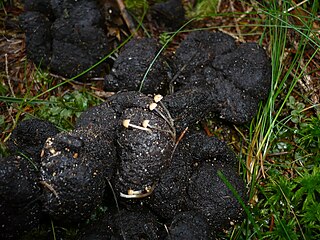
Tulosesus pellucidus is a species of mushroom producing fungus in the family Psathyrellaceae.
Tulosesus marculentus is a species of mushroom producing fungus in the family Psathyrellaceae.
Tulosesus hiascens is a species of mushroom producing fungus in the family Psathyrellaceae.
Tulosesus heterosetulosus is a species of mushroom producing fungus in the family Psathyrellaceae.
Tulosesus velatopruinatus is a species of mushroom producing fungus in the family Psathyrellaceae.
Tulosesus sclerocystidiosus is a species of mushroom producing fungus in the family Psathyrellaceae.
Tulosesus sassii is a species of mushroom producing fungus in the family Psathyrellaceae.
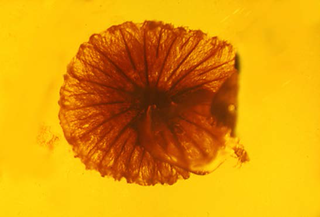
Coprinites is an extinct monotypic genus of gilled fungus in the Agaricales family Agaricaceae. At present it contains the single species Coprinites dominicana.
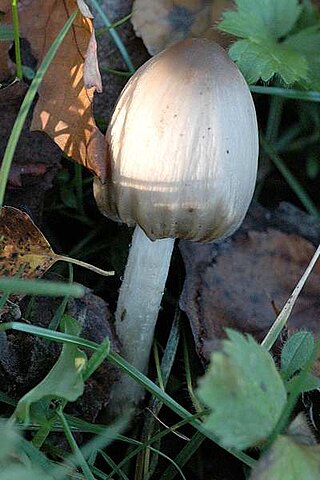
Coprinopsis acuminata, commonly known as the humpback inkcap mushroom and earlier as Coprinus acuminatus, is a coprophilous fungus that grows on herbivore dung. It is heterothallic.
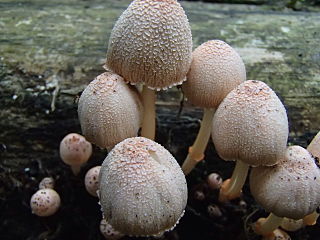
Coprinopsis mexicana is a species of fungus in the family Psathyrellaceae. Originally described in 1918 as Coprinus mexicanus by American mycologist William Alphonso Murrill, it was transferred to Coprinopsis in 2001.










